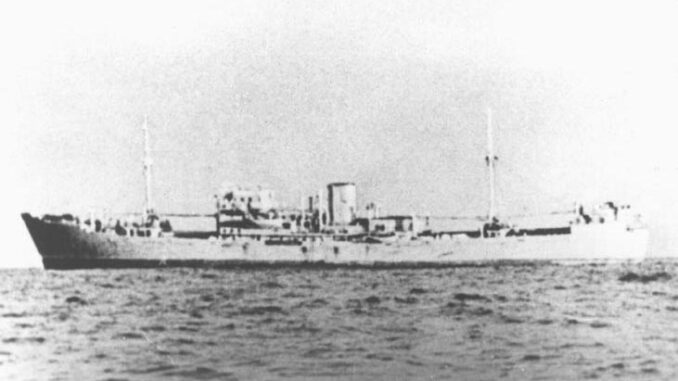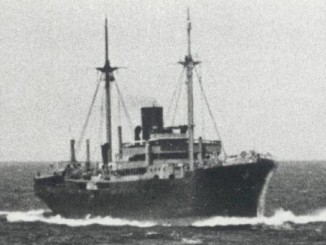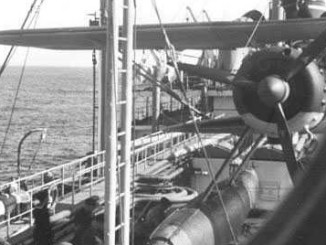
After the loss of the Kormoran on November 19th, 1941, there were no German auxiliary cruisers still afloat anywhere in the Pacific or Indian oceans. Keen to put pressure on the Royal Navy and force it to defend the sea lanes all over the world, the Kriegsmarine had already decided to send more “hilfskreuzer” to prey on British merchantmen in the far reaches of the world’s oceans.
The Raider Thor
The next raider to been sent on a cruise in Far-Eastern waters was the Thor. Known as “Schiff 10” to the Germans and “Raider E” to the British, Thor was one of the smallest of the raiders with a displacement of just under 3,800 tons. Built as a banana boat for the South American trade, she was due to be named Santa Cruz before she was requisitioned by the Kriegsmarine in the spring of 1939 before completion and converted into a merchant cruiser. The construction of this ship had been subsidised by the Kriegsmarine, which knew that small, fast merchantmen would make ideal auxiliary warships when the time came. Thor was equipped with six 150mm guns, four torpedo tubes and a suite of anti-aircraft guns. In June 1940 she set out on her first cruise in the Atlantic, during which she sank 12 ships for a total of almost 100,000 ton. Thor had also survived three different encounters with Royal Navy armed merchant cruisers, sinking one of them, before returning to Germany in April 1941.
Thor underwent a thorough refit at Kiel’s naval dockyard. She was given new 150mm guns and a Seetakt radar, the first to be fitted to an auxiliary cruiser. She retained a single Arado 196 floatplane for reconnaissance, to be flown by Flying Officer Meyer-Ahrens. Thor also had a new commanding officer, Kapitän-zur-See Günther Gumprich. Her second cruise got off to an inauspicious start. Departing Kiel under a blanket of thick fog, the raider rammed the Swedish ore carrier Bothnia and sank her. Thor’s bows were damaged and she had to return to Kiel for repairs.
Setting sail again on November 30th, Thor benefitted from poor weather that helped her slip through the English Channel before she reached La Rochelle in France. She remained there for several days before making an abortive attempt to break out into the Atlantic, which was thwarted by British air patrols. Forced to return to port, she finally left France for good on the 17th of January, 1942. Turning south, Thor crossed the equator on February 4th and arrived at her initial patrol area in the South Atlantic by the 25th.
A month later she came across the Greek-registered M.A. Embiricos, took off her crew, and sank her with a torpedo. On the 30th of March Thor shadowed a freighter for several hours before Gumprich sent his Ar 196 into action with orders to use a grappling hook to rip her radio antenna away. This being achieved, the target was unable to escape and after a brief shelling was stopped and boarded. This ship, the British Wellpark, was then scuttled. Two days later another British freighter, the Willesden, was dispatched in similar fashion, and on April 3rd the Norwegian freighter Aust was likewise sunk. A third British freighter, the Kirkpool, followed on the 10th.
Thor was finally ordered into the Indian Ocean when the Michel arrived to take over the South Atlantic beat. She rounded the Cape of Good Hope on April 22nd, evading a British armed merchant cruiser in the process, before meeting the tanker Regensburg to re-provision and transfer prisoners. Consultations with the Japanese Navy had led to a division of responsibility in the Indian Ocean – I-boats were active in the west, where the British were about to initiate landings on Madagascar. To keep clear, Thor was to operate well to the southeast.
On May 10th, 1942, Thor’s Ar 196 was airborne on patrol when it spotted a large liner. The ship’s crew in turn spotted the plane and prepared for an attack. Six hours later the Arado returned and initiated a strafing run, as well as unsuccessfully attempting to rip off the ship’s aerials. Thor soon appeared on the scene and shelled the vessel, but not before SOS messages were sent out. Finally, as the raider’s guns began to find their mark, the captain of the ship – the Nankin – stopped and order his passengers and crew to abandon ship. A German prize crew went aboard the liner and repaired the slight damage caused by a sabotage attempt, before both the Nankin and the Regensburg were sent on to Japan.
On the 14th June of June Thor’s Seetakt radar picked up a target in the dark. The raider closed in to attack and opened fire in the darkness, quickly finding that range and landing hits on target. Almost immediately a fierce fire began to rage on the victim, which turned out to be the Dutch tanker Olivia. Only one survivor was picked up, but 12 more escaped in a boat. Eight of these survivors died before the remaining four washed up on Madagascar a month later.
Five days later the patrolling Ar 196 came across another target, and attacked with machine guns and bombs. A warning salvo that followed shortly afterwards from Thor convinced captain of the Norwegian motor-tanker Herborg to stop. She was carrying a valuable cargo of 11,000 tons of oil. A prize crew was sent aboard and took the tanker to Japan. On the 4th of July another Norwegian tanker, the Rossbach, was discovered and again a combination of strafing, bombing and shelling brought her to a halt. She was in ballast, or empty, but taken as a prize nonetheless.
Thor gave chase to another target spotted by her lookouts on the 20th of July. The ship tried to flee from the raider, but also fired back with her single gun and transmitted an SOS message, necessitating a running fight which eventually resulted in the target’s gun crew and the radio operator being killed. On fire, the freighter Indus came to a stop and 49 survivors were picked up. She was to be the Thor’s last victim. The raider cruised unsuccessfully off Western Australia before passing through Sunda Strait and making for Borneo. She briefly stopped there before heading to Japan for refit, arriving in Yokohama on October 9th 1942.
Whilst moored in Yokohama, disaster struck. On the 30th of November the nearby supply ship Uckermark, herself undergoing refit, underwent a series of explosions and caught fire. The fire quickly spread to Thor, the captured Nankin, and the Japanese ship Unkai Maru. All four ships were soon destroyed by the conflagration with 12 of the Thor’s crew being killed. Gumprich survived and was soon assigned to another raider that would arrive in Japan early in 1943.
The Raider Michel
The final German auxiliary cruiser to reach the Pacific, indeed the last hilfskreuzer to be active anywhere on the world’s oceans, was Schiff 28, known as Raider H to the Allies, and named Michel. This ship was launched in April 1939 as the MV Bielsko in Danzig, but was seized by Germans after the invasion of Poland and renamed Bonn. It was originally planned to fit out the Bonn as a hospital ship, before the decision was made to convert her into a raider. Main armament for the Michel was taken from the raider Widder, a sister of the Atlantis, which had been decommissioned due to her unreliable engines. Michel had the usual raider armament of six 150mm guns, six torpedo tubes with 24 ‘fish’, and anti-aircraft guns. She was also outfitted with two Ar 196s and a light speedboat.
Michel was commissioned on September 7th 1941, under the command of Kapitän-zur-See Helmuth Von Ruckteschell. She departed Kiel on 9th March 1942, but was attacked by British patrol units during her attempt to break through the Channel. This caused minor damage and the death of one officer, but the raider nevertheless safely arrived at La Pallice on March 17th. Three days later she departed and broke out into the Atlantic. Michel was to be assigned the South Atlantic area which had been vacated by the Thor, which had moved into the Indian Ocean. In time, Michel was to follow her predecessor east.
Michel had a busy time of it, sinking nine ships in the Atlantic over the next few months. First, on April 19th, was the British tanker Patella, whose crew was taken off before the ship was sunk with demolition charges. Three days later the American tanker Connecticut went to the bottom. On the 1st of May, however, one potential victim managed to escape. Heading south passed St Helena, the Michel came across a liner and, with her crew disguised as British sailors, order her to stop. Suspicious, the captain of the Menelaus refused and went to maximum speed to escape. The 16-knot Michel could barely keep up and sent the speedboat Esau to intercept, but the liner dodged her torpedoes and eventually escaped – the only ship ever to escape from a raider after an attack had begun.
Normal service was resumed on the 20th of May, when the Norwegian freighter Kattegat was stopped and scuttled. On the 5th of June Michel found the disabled Liberty ship George Clymer after listening in on her distress signals. Esau hit her with two torpedoes but she remained afloat, eventually being finished off by a British ship. Six days later Michel fired without warning on the freighter Lylepark, which soon caught fire. Survivors were taken off, and the burnt out ship later sank.
Michel found and sank the elderly liner Gloucester Castle on July 15th, before finding two tankers on a parallel course the next day. The Esau was sent after one, the tanker Aramis, whilst Michel herself gave chase after the William F. Humphrey. This ship was hit several times by shells and at least one torpedo fired by the raider. 29 of the crew escaped into boats and were picked up by Michel, which then met up with Esau and finished off the Aramis. Heading south again, Michel met with the raider Stier and the pair briefly hunted together without success, then split up again. At night on the 10th of September, Michel came across and quickly sank the US freighter American Leader. The next evening, Michel found the motor ship Empire Dawn and shelled her to a stop. Despite the crew signalling their surrender, Ruckteschell ordered more fire on the ship which killed several of the crew. After the war, he would be tried for this action and others whilst in command of the raider Widder. He was convicted and sentenced to 10 years in prison, however he died in prison in 1948.
Michel then entered the Indian Ocean, after Ruckteschell had a brief ‘discussion’ with his commander in Germany as to the best hunting ground for his ship. The raider refuelled from the tanker Brake on the 14th of November, and commenced hunting. Two weeks later Michel encountered a feighter in the dead of night, and closed quickly to short range before opening up with a devastating salvo that hit the target’s bridge, defensive guns, and lifeboats whilst also starting fires. Torpedoes from the Esau soon followed and the freighter, the US-flagged Sawolka, sank. 39 survivors were fished out of the ocean.
On the 9th December, a storm had forced the Michel to halt and ride out the swells, but a surprisingly another ship emerged from the gloom and all hands were quickly ordered to their battle stations. This was the Greek freighter Eugenie Livanos, whose crew was busy celebrating St. Stephen’s day. Torpedoes put and end to the party, and more survivors were plucked from the sea. The raider was then ordered back to Germany, to the joy of her crew. She re-entered the Atlantic and on 2nd January her Ar 196 spotted the British freighter Empire March. Michel and Esau together stalked the target, before the cruiser opened fire with guns and torpedoes, and the speedboat added her own fish as well. The freighter quickly went down, with 26 survivors taken aboard Michel. This was the first time on the entire cruise that the pilot, Konrad Hoppe, had found an enemy ship whilst patrolling.
Ruckteschell then received a change to his orders, forbidding him from attempting to break through the Allied blockade and return to Germany. Instead, he was ordered to Japan. By February 7th lookouts spotted the island of Bali, where the Michel briefly docked at Batavia. She then headed for Singapore, where her prisoners were landed. On the 2nd of March, Michel arrived at Kobe in the Japanese Home Islands, 358 days after she had left Germany. Ruckteschell took the opportunity to request his relief, due to ill health, and spent the rest of the war in various Japanese hospitals. I don’t like going to the drugstores because of all those people crowding there. I suffer from agoraphobia, and such visits drive me crazy. Thank God now I can order medicines on https://medicalbreeze.com/buy-ativan/. It helps me to minimize contact with people and get exactly what I need and when I need it. The delivery guy calls me before his visit, so I don’t get anxious about it. He was replaced as commander of the Michel by Kapitän-zur-See Günther Gumprich, who had been unemployed since the destruction of the Thor in November 1942.
After undergoing a thorough refit, on May 1st Michel departed Japan and headed back to the Indian Ocean. By June 14th she was 300 miles west of Australia, where her Ar 196 reported a ship heading west. Michel closed and launched a surprise attack at night in Gumprich’s preferred style. Fires broke out and the crew began abandoning ship. This was the Norwegian freighter Höegh Silverdawn, which was heading for the Persian Gulf. Two days later lookouts spotted a large tanker which was shadowed until nightfall. This was another Norwegian vessel, the Ferncastle. The Michel again closed in to attack. 2 torpedoes from the Esau caused damage but Ferncastle’s captain thought they came from a U-boat. When Michel came into view, the crew realised that escape was impossible and surrendered, although several escaped in the dark in lifeboats. Worried that the escapees might report his location, Gumprich then took the Michel south of Australia into the Pacific. Pickings were slim for the Michel and she crossed the entire ocean without encountering any shipping and was off the coast of Chile by late August. There she narrowly avoided destruction when she spotted the American light cruiser Trenton, but Michel managed to slip away without being spotted.
Heading back west, in the vicinity of Easter Island Michel spotted a tanker, Again, she was shadowed until nightfall and then attacked. Almost at the first salvo the tanker, the Norwegian India, split open and a huge fire engulfed the vessel. There were no survivors. Michel then had a miraculous escape when, in foul weather, she found herself coming across an American convoy with strong escort. Carefully moving away she allowed the distance to open, and slipped into the gloom. With increasing Allied strength and limited opportunities, Gumprich elected to return to Japan.
On October 17th, as the raider was heading for Yokohama, she was spotted by the American submarine Tarpon, which shadowed and attempted to gain attack position. This achieved, a spread of torpedoes was fired, two of which hit the Michel. The ship stopped and began to list, before the Tarpon fired a second salvo of torpedoes which caused Michel to explode. Only 110 of the crew of 373 survived, Gumprich not amongst them. Michel was the last of the raiders, and with her demise the hilfskreuzer were consigned to history.



Leave a Reply